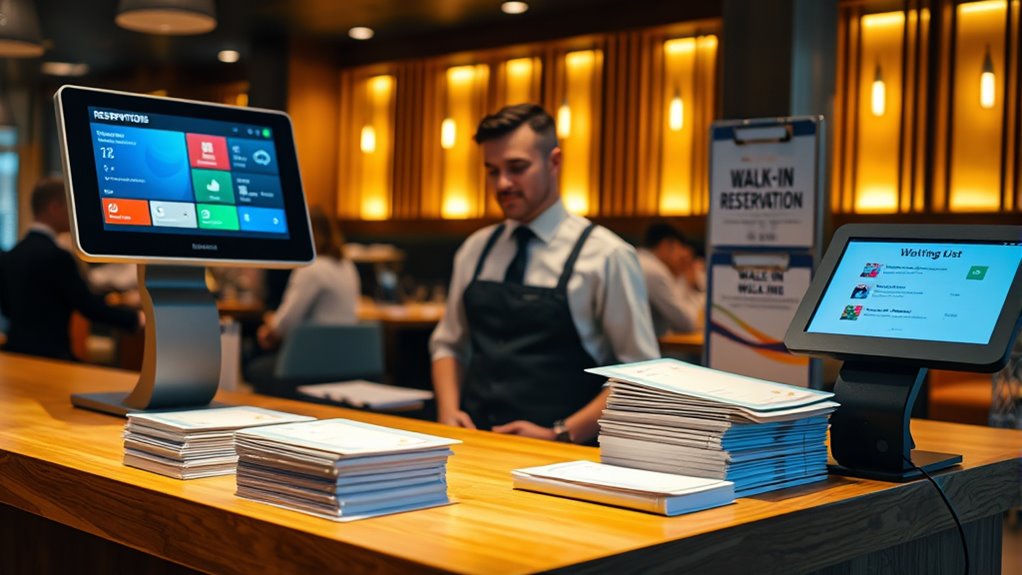A host stand workflow involves managing reservations, guest seating, and communication to make certain of smooth service. You confirm bookings, track arrivals, and assign tables efficiently. Greeting guests warmly and prioritizing seating based on reservations or preferences helps reduce wait times. Coordinating seamlessly with servers and the kitchen keeps everything organized and avoids mistakes. If you want to understand how to optimize these processes for a better guest experience, there’s more to explore below.
Key Takeaways
- Reservation management streamlines guest arrivals and reduces wait times through booking tracking and table assignments.
- Guest seating involves welcoming, reservation checks, wait time communication, and prioritization for efficient flow.
- Communication and coordination ensure seamless info exchange between hosts, servers, kitchen, and management.
- Organization and environment focus on maintaining a clean, organized host stand with clear signage and quick table identification.
- Overall workflow enhances guest experience by executing reservation and seating processes efficiently and with friendliness.

A smooth host stand workflow is essential for providing excellent guest service and keeping your restaurant running efficiently. When it comes to reservation management, your goal is to streamline the process so that guests feel valued from the moment they arrive. Proper reservation management involves tracking upcoming bookings, confirming reservations, and accommodating special requests. Using a reliable system—whether digital or manual—helps prevent overbooking and ensures that your staff can prepare for busy times. As reservations come in, you can assign tables in advance, reducing wait times and minimizing confusion when guests arrive. This proactive approach not only improves guest satisfaction but also helps your team work more cohesively.
Guest seating is another critical element in the host stand workflow. Once guests arrive, your task is to seat them promptly and efficiently. This requires a clear understanding of your restaurant’s layout and current table availability. When guests approach, you should greet them warmly and ask if they have a reservation or prefer to wait. If they’re waiting, communicate estimated wait times honestly to manage expectations. When seating guests, prioritize fairness and consistency, whether it’s by reservation time, party size, or seating preferences. Good guest seating also involves balancing the flow of your restaurant—avoiding bottlenecks at the host stand and ensuring that servers receive their tables in a manageable order. Maintaining an organized seating chart or digital display can help you quickly identify available tables and assign them without delay.
Efficiency at the host stand hinges on effective communication. You need to coordinate seamlessly with your servers, kitchen, and management team to keep the flow smooth. For example, once a table is ready, inform the server immediately so they can greet the guests without unnecessary wait. If a reservation is canceled or a walk-in arrives unexpectedly, you should quickly adjust your plan to accommodate new guests. Keeping track of guest preferences, special occasions, or allergies at this stage allows you to personalize the experience, making guests feel recognized and valued.
In addition, maintaining a calm, organized environment at the host stand helps prevent mistakes and reduces guest frustration. Use clear signage, a well-maintained reservation system, and a clean, uncluttered space to improve overall efficiency. By mastering reservation management and guest seating, you create a host stand workflow that enhances guest satisfaction, optimizes table turnover, and supports your restaurant’s success. Every step, from greeting to seating, should be executed with precision and friendliness to ensure a smooth, welcoming experience for all.
Frequently Asked Questions
How Do I Handle Guest Complaints Effectively?
To handle guest complaints effectively, focus on conflict resolution by listening carefully and empathizing with their concerns. Stay calm and professional, acknowledging their feelings and showing genuine concern. Offer solutions promptly to improve guest satisfaction, such as alternative seating or compensations if appropriate. Your active engagement demonstrates you value their experience, helping to turn a negative situation into a positive one, and ensuring they leave satisfied and valued.
What Are Best Practices for Managing Waitlists?
Imagine managing your waitlist like a trusty telegram — quick, clear, reliable. To do this effectively, prioritize reservation management by keeping accurate, real-time updates. Communicate waitlist status promptly and politely to guests, offering estimated wait times and options. Always stay organized, and don’t forget to follow up if delays occur. This approach guarantees guests feel valued and informed, making your waitlist smoother and more manageable.
How Can I Improve Guest Seating Efficiency?
To improve guest seating efficiency, focus on reservation management and guest flow optimization. Use real-time updates to monitor arrivals and table availability, reducing wait times. Implement a system to prioritize reservations and walk-ins smoothly, ensuring guests are seated promptly. Train staff to communicate effectively and stay organized. By streamlining these processes, you’ll enhance overall guest experience and maximize seating capacity without sacrificing service quality.
What Tools Assist in Host Stand Workflow?
You can improve your host stand workflow by using reservation management tools that streamline booking and check-in processes. These tools help you efficiently manage reservations and quickly assign tables, reducing wait times. Digital systems allow real-time updates on table availability and guest status, making table assignment smoother. By leveraging these tools, you’ll enhance guest experiences, optimize seating efficiency, and keep your workflow organized and responsive throughout busy hours.
How Do I Train New Host Staff Quickly?
To train new host staff quickly, focus on guest greeting and reservation management. Show them how to warmly welcome guests and efficiently check reservations using your system. Practice role-playing scenarios to build confidence and guarantee they understand the flow. Provide clear, step-by-step instructions and encourage questions. Use real examples to reinforce learning, and give immediate feedback so they can improve fast and handle guests smoothly from day one.
Conclusion
As you smoothly manage the host stand, imagine the gentle hum of conversations blending with the clink of silverware, creating a welcoming rhythm. Your attentive gestures guide guests to their seats like a conductor leading an orchestra. With each smile and quick response, you transform an ordinary moment into a warm welcome. When you master this workflow, you craft an inviting atmosphere where every guest feels valued, leaving with a smile as bright as the restaurant’s shining lights.









